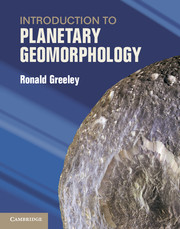Book contents
- Frontmatter
- Contents
- Foreword
- Preface
- Acknowledgments
- Chapter 1 Introduction
- Chapter 2 Planetary geomorphology methods
- Chapter 3 Planetary morphologic processes
- Chapter 4 Earth’s Moon
- Chapter 5 Mercury
- Chapter 6 Venus
- Chapter 7 Mars
- Chapter 8 The Jupiter system
- Chapter 9 The Saturn system
- Chapter 10 The Uranus and Neptune systems
- Chapter 11 Planetary geoscience future
- Appendices
- References
- Further Reading
- Index
Chapter 7 - Mars
Published online by Cambridge University Press: 05 February 2013
- Frontmatter
- Contents
- Foreword
- Preface
- Acknowledgments
- Chapter 1 Introduction
- Chapter 2 Planetary geomorphology methods
- Chapter 3 Planetary morphologic processes
- Chapter 4 Earth’s Moon
- Chapter 5 Mercury
- Chapter 6 Venus
- Chapter 7 Mars
- Chapter 8 The Jupiter system
- Chapter 9 The Saturn system
- Chapter 10 The Uranus and Neptune systems
- Chapter 11 Planetary geoscience future
- Appendices
- References
- Further Reading
- Index
Summary
Introduction
Few objects in the sky hold the fascination in the public mind as much as Mars. Easily seen with the naked eye, the “Red Planet” has been linked with various gods of war through the ages. The late 1800s and early 1900s saw both serious and not-so-serious writings on martian life, including the presence of advanced civilizations, and culminating in the infamous radio broadcast of H. G. Wells’s fictional War of the Worlds, in which martian spacecraft land on Earth. This broadcast filled many a family with terror as the story unfolded with the destruction of whole cities.
Building on public support for the exploration of Mars, the Red Planet has been visited by more spacecraft than any other object except Earth’s Moon. Along with Europa and possibly Titan, Mars is a favorable planet in the exploration for possible present-day or past life.
With a diameter of 6,779 km and a mass of 6.4 × 1023 kg, Mars gravity is 0.37 that of Earth. The total surface area of Mars is just about equal to the land surface on Earth above sea level. One Mars year is 686.98 Earth days, while one Mars day is 24 hr, 39m, 35.2 s. Its present-day spin axis is inclined 25.19° (slightly more than Earth), which leads to distinctive seasons. The seasons are defined by Mars’ position in orbit and described by aerocentric longitudes (Ls) of the Sun in degrees. Ls is the angle between the Mars–Sun line and the line of equinoxes. Ls of 0° is set at the martian equinox for the beginning of winter in the northern hemisphere (Ls 0° to 90°), with northern spring (Ls 90° to 180°), northern summer (Ls 180° to 270°), and northern autumn (Ls 270° to 360°).
Information
- Type
- Chapter
- Information
- Introduction to Planetary Geomorphology , pp. 126 - 146Publisher: Cambridge University PressPrint publication year: 2013
